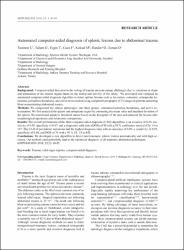| dc.contributor.author | Teomete, U. | en_US |
| dc.contributor.author | Tulum, Gökalp | en_US |
| dc.contributor.author | Ergin, T. | en_US |
| dc.contributor.author | Cüce, F. | en_US |
| dc.contributor.author | Köksal, M. | en_US |
| dc.contributor.author | Dandin, O. | en_US |
| dc.contributor.author | Osman, Onur | en_US |
| dc.date.accessioned | 2019-06-24T09:23:52Z | |
| dc.date.available | 2019-06-24T09:23:52Z | |
| dc.date.issued | 2019 | en_US |
| dc.identifier.citation | Teomete, U., Tulum, G., Ergin, T., Cuce, F., Koksal, M., Dandin, O., & Osman, O. (2018). Automated computer-aided diagnosis of splenic lesions due to abdominal trauma. Hippokratia, 22(2), 80-85. | en_US |
| dc.identifier.issn | 1108-4189 | |
| dc.identifier.uri | https://hdl.handle.net/20.500.12294/1500 | |
| dc.description | Tulum, Gökalp (Arel Author), Osman, Onur (Arel Author) | en_US |
| dc.description.abstract | Background: Computer-aided detection in the setting of trauma presents unique challenges due to variations in shape and attenuation of the injured organs based on the timing and severity of the injury. We developed and validated an automated computer-aided diagnosis algorithm to detect splenic lesions such as laceration, contusion, subcapsular hematoma, perisplenic hematoma, and active extravasation using computed tomography (CT) images in patients sustaining blunt or penetrating abdominal trauma. Methods: We categorized the splenic pathologies into three groups: contusion/laceration, hematoma, and active extravasation. We first analyzed the spleen and perisplenic region by estimating the mean value and standard deviation of the spleen. We determined adaptive threshold values based on the histogram of the area and detected the lesions after morphological operations and volumetric comparisons. Results: The overall performance of the three computer-aided diagnosis (CAD) algorithms is an accuracy of 0.80, sensitivity of 0.95, specificity of 0.67, and a diagnostic odds ratio (DOR) of 40 with a 95 % confidence interval (CI): 14 to 117. The CAD of perisplenic hematoma had the highest diagnosis rates with an accuracy of 0.90, a sensitivity of 0.95, specificity of 0.80, and DOR of 76 with a 95 % CI: 13 to 442. Conclusions: We developed a new algorithm to detect post-traumatic splenic lesions automatically and with high accuracy. Our method could potentially lead to the automated diagnosis of all traumatic abdominal pathologies. | en_US |
| dc.language.iso | eng | en_US |
| dc.publisher | Lithographia | en_US |
| dc.relation.ispartof | Hippokratia | en_US |
| dc.rights | info:eu-repo/semantics/openAccess | en_US |
| dc.subject | Trauma | en_US |
| dc.subject | Solid Organ Injuries | en_US |
| dc.subject | Computer-Aided Diagnosis | en_US |
| dc.title | Automated computer-aided diagnosis of splenic lesions due to abdominal trauma | en_US |
| dc.type | article | en_US |
| dc.department | Mühendislik ve Mimarlık Fakültesi, Elektrik-Elektronik Mühendisliği Bölümü | en_US |
| dc.authorid | https://orcid.org/0000-0003-2865-5781 | en_US |
| dc.authorid | https://orcid.org/0000-0001-7675-7999 | en_US |
| dc.identifier.volume | 22 | en_US |
| dc.identifier.issue | 2 | en_US |
| dc.identifier.startpage | 80 | en_US |
| dc.identifier.endpage | 85 | en_US |
| dc.relation.publicationcategory | Makale - Uluslararası Hakemli Dergi - Kurum Öğretim Elemanı | en_US |


















